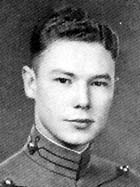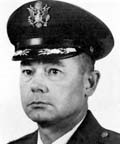Courtesy of his classmates, United States Military Academy:
Hugh Fagan Jordan
No. 13381 • 4 August 1919 – 16 February 1972
Died in Greenville, North Carolina, aged 52 years
Interment: Arlington National Cemetery, Arlington, Virginia
Hugh Jordan was a true product of North Carolina with roots deep into the state. Not only were his father and mother born there, as well, but also so was Evelyn Arps, who became his wife six hours after graduation. And it was to North Carolina that Hugh chose to retire.
Long desirous of being a soldier, Hugh attended Plymouth High School until 1936, then Porter Military Academy in Charleston, South Carolina, for a year, Braden’s in Cornwall in 1938, and North Carolina State for a year, before entering with our class. At West Point he wrestled at 127 lbs., shot skeet, and helped manage the track team. He also worked with the 100th Night Show and the Pointer, and was a Sunday School teacher. But our short first class year disappeared in his status as Air Cadet and the pilot training program.
Graduating with wings, Hugh was fighter instructor at Craig Field before going to Europe with the 79th Fighter-Bomber Group. The citation on the first of his two Distinguished Flying Crosses reads that he “ . . . led a 7-plane formation of P-47 Thunderbolts in an attack on enemy troops and gun positions…. He dove to minimum altitude and in the face of intense and accurate anti aircraft fire he guided his P-47s in a perfect run over the target…. During his flight Captain Jordan
returned to the target and in repeated strafing and rocket attacks inflicted further destruction upon the enemy before returning his formation safely to base.”
The citation also mentions that he had flown more than 75 missions against targets in France, Italy, Austria, Yugoslavia, and Germany.
By the end of the war, he had been awarded two DFCs and six Air Medals, along with the Presidential Unit Citation. Assignments followed to Command & General Staff College, Fort Riley, and Harvard for an MPA, and then teaching at West Point in the Department of Social Sciences. But the Korean War called, and Hugh reported to the Far Eastern Air Forces, where he won a Bronze Star; to the 8th Fighter-Bomber Wing, where he won two more Air Medals; and back to FEAF for another Bronze Star, but with his family along for the tour. After the Air Command & Staff School (his second) he reported to the Air Staff in Washington, where he won a Commendation Medal.
By 1960, Hugh began to specialize in Air Rescue. He first served in the Air Rescue Service until 1964 and then became Commander of the Central Air Rescue Center until 1967. Hugh reported to the Alaskan Command in 1968, but severe heart trouble finally cut his career short, and he retired in 1968 for physical disability. He and the family returned to North Carolina for retirement. But death came suddenly in 1972, and Ev returned to her hometown of Plymouth, where she and Hugh had
attended high school.
Hugh is survived by Ev and by their four children: Anne Bailey, born in North Carolina; Susan, born in Kansas; John, born in Boston; and Mary Evelyn, born in Tokyo.
Hugh’s service represents the best of dedication and heroism: a skillful and brave pilot in two wars, winning high awards for bravery in the air and professional competence on the ground. He adds glory to the reputation of West Point graduates, and reflects credit on us all. Rest in peace, brave colleague.
— His classmates
Michael Robert Patterson was born in Arlington and is the son of a former officer of the US Army. So it was no wonder that sooner or later his interests drew him to American history and especially to American military history. Many of his articles can be found on renowned portals like the New York Times, Washingtonpost or Wikipedia.
Reviewed by: Michael Howard


